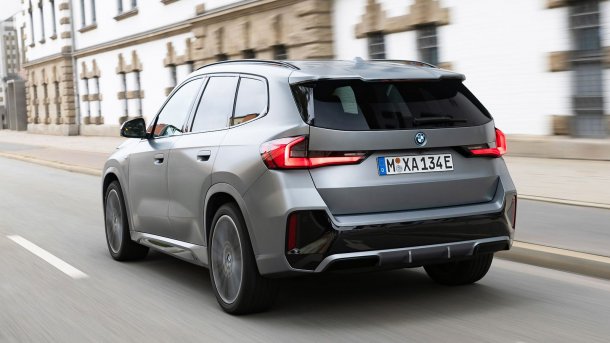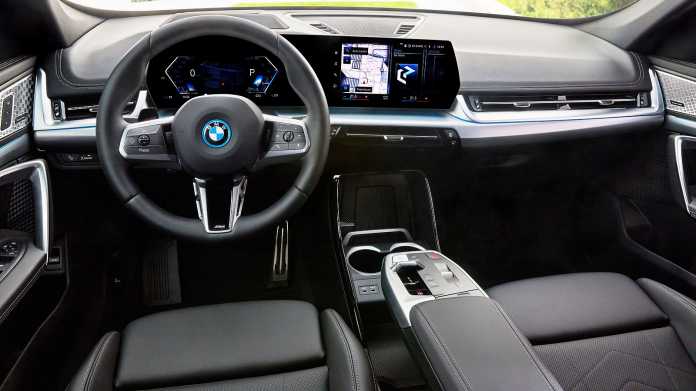BMW iX1: First drive with the electric SUV
BMW is taking a multi-track approach in the new X1: petrol and diesel are joined by plug-in hybrids and an electric drive. A first driving report.

BMW offers the third generation of the X1 as a petrol, diesel, plug-in hybrid and electric car.
(Bild: BMW)
(Hier finden Sie die deutsche Version des Beitrags)
The announcement was unmistakable: unlike almost all its competitors, BMW insists on pursuing other paths in addition to the battery-electric drive. One of these is hydrogen, used in a fuel cell. But even in the executive suites of the Munich four-cylinder, it is clear that the masses will probably drive battery-electric in the future. That's why BMW also offers the X1 as the iX1 electric car. It was available to us for a first drive.
Powerful start
BMW installs two e-motors that together deliver 230 kW. By internal count, this is the fifth generation of e-motors at BMW. It does not require any rare earths. The driving impression is typical of a modern electric car: powerful when pulling away, but pleasantly unspectacular acoustically. The full potential of the driving performance can only be utilised for more than a few seconds in exceptional situations. The factory figures of 5.7 seconds in the standard sprint are just as incomplete a reflection of the real conditions of the tracking ability as the informative value of the electronically limited top speed, which is 180 km/h.
Will there be an iX1 with less power?
Despite a kerb weight of two tonnes, the first iX1 feels very light on its feet. That's why we expect BMW to go downmarket and introduce the iX1 with a little less power. Mercedes did the same with the EQA and showed that the term "base model" should by no means be equated with a "no-frills solution". On the contrary, even with around 140 kW, a very, very well-powered car is already on offer.
BMW iX1 - exterior (4 Bilder)

130 kW DC charging power
In everyday life, many users will be more interested in how BMW has implemented the energy supply. The cell chemistry for the battery is NMC811, i.e. eight parts nickel, one part manganese and one part cobalt. The usable energy content is 64.7 kWh and thus minimally below what Mercedes offers in the EQA. BMW gives a range of 413 to 438 km depending on the equipment.
On direct current, the BMW can charge a little faster with a maximum of 130 kW, although this alone is of little significance. The EQA has shown in tests that it can maintain its highest charging power over a comparatively large charging window, but this has yet to be proven in the iX1 - this first drive was far too short for that, the request for a test car has already been made.
Up to 22 kW AC charging
The iX1 does not come close to the charging performance of companies like Tesla or Hyundai and their brands. BMW quotes 29 minutes for charging from 10 to 80 percent - this is certainly not a new record. However, the iX1 can shine in other areas, at least as an option. A three-phase AC charger with 11 kW is standard; for an as yet unknown surcharge, 22 kW can be charged at one of the comparatively widespread AC charging stations. Not many e-cars can currently offer this high AC charging power. The factory specifications for the unrealistic zero-to-100-percent charge are 6.5 hours (11 kW) and 3:45 hours (22-kW charger). In practice, this means that the iX1 can always be fully charged within the 240 minutes, beyond which blocking fees apply at many public charging stations.
According to the on-board computer, fuel consumption on this trip was 20.6 kWh/100 km; in the WLTP, BMW gives values of 17.3 to 18.4 kWh/100 km. However, the charging losses are included in the cycle, but not in the on-board computer. The real electricity consumption including the charging losses, which ultimately have to be paid for, depends on the type of charging. It is most expensive via the 10 A charging plug supplied, as the proportional losses are highest there. However, the number of e-car users who primarily use this option is probably quite small.
Pleasantly tuned chassis in the BMW iX1
The test car was equipped with the optional sports suspension, which did its job very well. The e-SUV can be driven nimbly around bends and still sets itself apart from the X1 models with combustion engines in terms of comfort. The iX1 xDrive30 absorbs transverse ruts more confidently and has a more harmonious suspension. The overall set-up seems more successful than recently experienced in the BMW X2 25e (test), for example. The iX1 shows its limits with a slight understeer.
BMW iX1 - interior (7 Bilder)

The steering, which responds very directly around the centre position, takes some getting used to. The steering never seems nervous, but the car reacts very quickly to small steering movements. BMW is aiming at the "active" driver, who will certainly appreciate this design. Drive influences are carefully filtered, which can be felt, among other things, in the fact that the feedback from the road is also muted.
In earlier times, BMW countered criticism of tightly cut interiors with the comparison to a tailor-made suit, which no one would buy a size too big. The iX1 is far from being tight. BMW quotes a volume of 490 to 1495 litres. At 4.5 m, the iX1 is about as long as a VW Tiguan and thus significantly shorter than, for example, a BMW 3 Series.
No more direct favourites buttons
The rest is already familiar from the other X1 models: The optional sports seats seem a little cramped at first, but prove to be very comfortable on long journeys. Only people with a very wide back should consider not spending these 400 euros. The workmanship is excellent, the choice of materials is of high quality. You have to get used to the logic of the "OS8" infotainment system, which may overwhelm some users with its wealth of options. Nevertheless, BMW has succeeded in sorting out the basic functions in a comprehensible way. The very good voice control system, which is one of the best currently available in a car, often helps. Nevertheless, we sorely missed the freely assignable favourite buttons that the predecessor still had. A menu with functions that you want to use frequently can now be found on the display when you swipe from top to bottom. This is better than nothing, although it is a little more complicated to use than before.
Price: The iX1 is the most expensive X1
With a list price of 55,000 euros, the iX1 is once again a bit pricier than the X1 models with combustion engine or plug-in hybrid. But the e-SUV benefits from government subsidies. Although only a few iX1 buyers are likely to receive the full amount, because the car is due to be in dealers' showrooms from November, the chance of being able to register an iX1 before the end of the year is likely to be small. The government's share of the purchase premium for vehicles with a net list price between 40,000 and 65,000 euros will drop from 5000 to 3000 euros from 1 January 2023. In total, the rebate including the manufacturer's share and the omission of VAT on this part of the premium will amount to just under 5000 euros from January 2023.
This makes the electric car about as expensive as the plug-in hybrid with 240 kW, which will no longer be subsidised in future, and the most powerful versions of the X1 with an internal combustion engine. For most people interested in the iX1, however, something else is probably important: For privately used, battery-electric company cars, different limits apply than originally stated in the text. Up to a gross list price of 60,000 euros, only 0.25 per cent of the list price must be taxed as a non-cash benefit. Only from 60,000 euros does the 0.5 per cent rule apply.This makes it considerably cheaper for this clientele than the X1 with a combustion engine. This way, they get the most pleasant drive in this SUV and also the one that is least harmful to the environment.
(mfz)